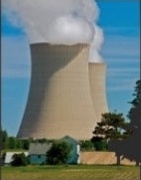[…]
Japan’s nuclear regulator has stated that this can be done safely and the International Atomic Energy Agency has supported this position. We would argue that there is insufficient information to assess potential impacts on environmental and human health and issuing a permit at this time would be premature at best.
Tokyo Electric Power Company Holdings Inc., the plant’s operator, is taking this step as part of the decommissioning and cleanup process of the plant. Every day, more than 150 tons of water accumulates at the site due to groundwater leakage into buildings and the systems used to cool the damaged reactors. The water is currently stored in more than 1,000 tanks at the site and what to do with their ever-increasing number has been a topic of concern for many years.
The justification for ocean discharge focuses largely on the assumed levels of radioactivity from tritium, a radioactive form of hydrogen that cannot be easily removed by an advanced liquid processing system, which is used for treating the contaminated water. To reduce tritium to levels that will be 1/40th of the regulatory standards, dilution of the tank water with seawater has been proposed prior to release. However, tritium is only part of the story, and a full assessment of all of the water contaminants stored in tanks at the site has yet to be made and verified by independent parties.
Our specific concerns include the adequacy, accuracy and reliability of the available data. A key measure of safety is a risk factor that combines the activities of more than 60 radioactive contaminants — the so-called sum of ratios approach. However, only a small subset of these radioactive contaminants — seven to 10 of them, including tritium — have been regularly measured. The assumption is that this subset alone will reflect the possible risks and the other contaminants are at constant levels. We disagree with this approach, as the data show wide variability in the contaminant concentrations between tanks, as well as differences in their relative amounts.
For example, some tanks low in tritium are high in strontium-90 and vice versa. Thus, the assumption that concentrations of the other radionuclides are constant is not correct and a full assessment of all 62 radioisotopes is needed to evaluate the true risk factors.
Moreover, only roughly a quarter of the more than 1,000 tanks at the site have been analyzed. This combined with the large variability among tanks, means that final dilution rates for tritium and the cleanup necessary for all contaminants are not well known. By Tepco’s own estimates, almost 70% of the tanks will need additional cleanup but that estimate is uncertain until all of the tanks are assessed.
The bottom line is that it is impossible to engineer and assess the impact of any release plan without first knowing what is in the tanks. The actual cost and duration of the project, as well as the amount of dilution needed, all depend upon the accuracy and thoroughness of the data. For example, the amount of seawater needed, and hence the time to release, will depend directly upon dilution factors.
Tepco stated in its radiological impact assessment that to meet its requirements, dilution will be needed by a factor “greater than 100.” In fact, the dilution rate we calculate is 250 on average and more than 1,000 times for many of the tanks where analyses are available. Scaling to those higher averages and extremes would increase capacity needs, costs and overall duration of the releases. In addition, comparisons against other possible disposal options — such as vapor release, using enhanced tritium removal technologies, geological burial or the storage option we suggest below — cannot be made without a better assessment of the current tank contents.
Even for tritium, its high levels are not adequately addressed, as it is assumed to be present only in inorganic form as tritiated water. However, there are also organically bound forms of tritium (OBT) that undergo a higher degree of binding to organic material. OBT has been found in the environment at other nuclear sites and is known to be more likely stored in marine sediments or bioaccumulated in marine biota. As such, predictions of the fate of tritium in the ocean need to include OBT as well as the more predictable inorganic form in tritiated water. Tepco has yet to do this.
The focus on tritium also neglects the fact that the nontritium radionuclides are generally of greater health concern as evidenced by their much higher dose coefficient — a measure of the dose, or potential human health impacts associated with a given radioactive element, relative to its measured concentration, or radioactivity level. These more dangerous radioactive contaminants have higher affinities for local accumulation after release in seafloor sediments and marine biota. The old (and incorrect) belief that the “solution to pollution is dilution” fails when identifying exposure pathways that include these other bioaccumulation pathways.
Although statements have been made that all radioactivity levels will meet regulatory requirements and be consistent with accepted practices, the responsible parties have not yet adequately demonstrated that they can bring levels below regulatory thresholds. Rebuilding trust would take cleanup of all of the tanks and then independently verifying that nontritium contaminants have been adequately removed, something the operator has not been able to do over the past 11 years. Post-discharge monitoring will not prevent problems from occurring, but simply identify them when they do occur.
As announced, the release of contaminated material from the Fukushima No. 1 nuclear power plant would take at least 40 years, and decades longer if you include the anticipated accumulation of new water during the process. This would impact not only the interests and reputation of the Japanese fishing community, among others, but also the people and countries of the entire Pacific region. This needs to be considered as a transboundary and transgenerational issue.
Our oceans provide about half of the oxygen we breathe and store almost one-third of the carbon dioxide we emit. They provide food, jobs, energy, global connectivity, cultural connections, exquisite beauty and biodiversity. Thus, any plan for the deliberate release of potentially harmful materials needs to be carefully evaluated and weighed against these important ocean values. This is especially true when contaminated material is being released that would be widely distributed and accumulated by marine organisms.
The Fukushima nuclear power plant disaster is not the first such incident, nor will it be the last. The challenge presented by this present situation is also an opportunity to improve responses and chart a better way forward than to dump the problem into the sea. Moreover, even accepted practices and guidelines require much more thorough preoperational analysis and preparation than is in evidence so far.
We conclude that the present plan does not provide the assurance of safety needed for people’s health or for sound stewardship of the ocean. We have reached this conclusion as members of an expert panel engaged by the Pacific Island Forum, a regional organization comprising 18 countries. However, we have penned this commentary in our individual capacities and our views may or may not be shared by the forum secretariat or its members.
The recent decision to support the release by the Nuclear Regulation Authority is surprising and concerning. In addition, the International Atomic Energy Agency should withhold its support for the release without these issues being resolved. Once the discharge commences, the opportunity to examine total costs and weigh the ocean discharge option against other alternatives will have been lost.
It has been stated that there is an urgency to release this contaminated water because the plant operator is running out of space on site. We disagree on this point as well, as once the tanks are cleaned up as promised, storage in earthquake-safe tanks within and around the Fukushima facility is an attractive alternative. Given tritium’s 12.3-year half-life for radioactive decay, in 40 to 60 years, more than 90% of the tritium will have disappeared and risks significantly reduced.
This is the moment for scientific rigor. An absence of evidence of harm is not evidence that harm will not occur, it simply demonstrates critical gaps in essential knowledge. Having studied the scientific and ecological aspects of the matter, we have concluded that the decision to release the contaminated water should be indefinitely postponed and other options for the tank water revisited until we have more complete data to evaluate the economic, environmental and human health costs of ocean release.
Ken Buesseler is a senior scientist at the Woods Hole Oceanographic Institution and director of the Center for Marine and Environmental Radioactivity. Ferenc Dalnoki-Veress is scientist-in-residence at the Middlebury Institute of International Studies at Monterey. Antony M. Hooker is director of the Center for Radiation Research, Education and Innovation at the University of Adelaide. Arjun Makhijani is president of the Institute for Energy and Environmental Research. Robert H. Richmond is director of the Kewalo Marine Laboratory at the University of Hawaii at Manoa.
Read more.




